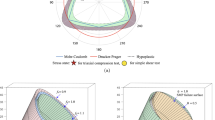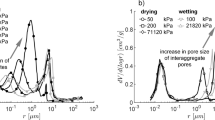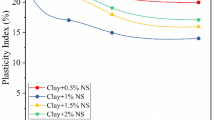Abstract
In the last few decades, a lot of research has focused on the radiation interaction with complex materials such as soil. The mass attenuation coefficient (\(\mu\)) is important to analyze the different physical properties of porous media. For this reason, it is important to understand how \(\mu\) varies as a function of the chemical composition of porous materials. This study analyzes the influence of the chemical composition on \(\mu\), from \(1\) to \(1500 \mathrm{keV}\), using the XCOM computer simulation code. Five types of soil, containing variable proportions of \({\mathrm{SiO}}_{2}\), \({\mathrm{Al}}_{2}{\mathrm{O}}_{3}\), \({\mathrm{Fe}}_{2}{\mathrm{O}}_{3}\), and \({\mathrm{TiO}}_{2}\), were evaluated. The results showed that the influence of each of the partial effects (photoelectric, coherent, and incoherent scattering), in \(\mu\) values, occurred from their dependence on the atomic number (\(Z\)), with greater \(Z\) influence in low energies. A detailed analysis of the influence of the chemical composition considering the oxides individually is also presented. In addition, this paper brings a comprehensive description of the methodology employed for the measurements of the radiation interaction main effects and it can also be used to teach physics applied courses in areas such as modern physics, dosimetry, and radiation protection, among others.







Similar content being viewed by others
Availability of Data and Material
Not applicable.
Code Availability
Not applicable.
References
M.E. Medhat, L.F. Pires, R.C.J. Arthur, J. Radioanal. Nucl. Chem. (2014). https://doi.org/10.1007/s10967-014-3028-y
A. Un, Y. Sahin, Nucl. Instrum. Methods Phys. Res. B (2012). https://doi.org/10.1016/j.nimb.2012.07.031
D. Reilly, N. Ensslih, H. Smith Jr, S. Kreiner, Passive nondestructive assay of nuclear materials, 1a ed. (US Nuclear Regulatory Commission, Washington, 1991), pp. 27–42
S.R. Manohara, S.M. Hanagodimath, Nucl. Instrum. Methods Phys. Res. B (2007). https://doi.org/10.1016/j.nimb.2008.06.034
G.S. Bhandal, K. Singh, Appl. Radiat. Isot. (1993). https://doi.org/10.1016/0969-8043(93)90048-F
I. Han, L. Demir, M. Şahin, Radiat. Phys. Chem. (2009). https://doi.org/10.1016/j.radphyschem.2009.03.077
L.F. Pires, F.A.M. Cássaro, L. Tech, L.A.A. Pereira, J.A.T. Oliveira, Rev. Bras. Ens. Fis. (2020). https://doi.org/10.1590/1806-9126-rbef-2019-0340
J.C. Costa, J.A.R. Borges, L.F. Pires, R.C.J. Arthur, O.O.S. Bacchi, Ann. Nucl. Energy (2014). https://doi.org/10.1016/j.anucene.2013.10.006
T.R. Ferreira, L.F. Pires, A.M. Brinatti, A.C. Auler, J. Soils Sediments (2018). https://doi.org/10.1007/s11368-017-1866-2
L.F. Pires, Soil Tillage Res. (2018). https://doi.org/10.1016/j.still.2018.07.015
L.F. Pires, L.V. Prandel, S.C. Saab, Geoderma (2014). https://doi.org/10.1016/j.geoderma.2013.09.003
J.A.T. Oliveira, F.A.M. Cássaro, L.F. Pires, Rev. Bras. Ens. Fis. (2020). https://doi.org/10.1590/1806-9126-rbef-20200192
I. Akkurt, B. Mavi, A. Akkurt, C. Basyigit, S. Kilincarslan, H.A. Yalim, J. Quant. Spectrosc. Radiat. Transf. (2005). https://doi.org/10.1016/j.jqsrt.2004.09.024
G.S. Mudahar, M. Sanjay, M. Singh, Appl. Radiat. Isot. (1991). https://doi.org/10.1016/0883-2889(91)90118-K
R. Cesareo, J.T. Assis, S. Crestana, Appl. Radiat. Isot. (1994). https://doi.org/10.1016/0969-8043(94)90205-4
M.N. Alam, M.M.H. Miah, M.I. Chowdhury, M. Kamal, S. Ghose, R. Rahman, Appl. Radiat. Isot. (2001). https://doi.org/10.1016/S0969-8043(00)00354-7
I. Han, L. Demir, J. X-ray Sci. Technol. (2010). https://doi.org/10.3233/xst-2010-0238
V. Trunova, A. Sidorina, V. Kriventsov, Appl. Radiat. Isot. (2015). https://doi.org/10.1016/j.apradiso.2014.09.017
M.E. Medhat, L.F. Pires, X-ray Spectrom. (2016). https://doi.org/10.1002/xrs.2689
A.H. Taqi, H.J. Khalil, J. Radiat. Res. Appl. Sci. (2017). https://doi.org/10.1016/j.jrras.2017.05.008
N. Kucuk, Z. Tumsavas, M. Cakir, J. Radiat. Res. (2013). https://doi.org/10.1093/jrr/rrs109
L.V. Prandel, S.C. Saab, L.M.S. Tonial, A.M. Brinatti, L.F. Pires, Braz. Arch. Biol. Technol. (2021). https://doi.org/10.1590/1678-4324-2021190760
M.J. Berger, J.H. Hubbell, S.M. Seltzer, J. Chang, J.S. Coursey, R. Sukumar, D.S. Zucker, K. Olsen, XCOM: Photon Cross Section Database. (NIST Physical Measurement Laboratory, 2010). http://physics.nist.gov/xcom. Accessed 12 December 2020
P.S. Kore, P.P. Pawar, Radiat. Phys. Chem. (2014). https://doi.org/10.1016/j.radphyschem.2013.12.038
I. Kaplan, Nuclear Physics, 1ª ed. (Addison-Wesley Publishing Company, Cambridge, 1963)
F.H. Attix, Introduction to Radiological Physics and Radiation Dosimetry, 1ª ed. (Wiley – VCH, Weinheim, 2004)
C.R. Appoloni, E.A. Rios, Appl. Radiat. Isot. (1994). https://doi.org/10.1016/0969-8043(94)90041-8
J.C.M. Oliveira, C.R. Appoloni, M.M. Coimbra, K. Reichardt, O.O.S. Bacchi, E. Ferraz, S.C. Silva, W. Galvão Filho, Soil Tillage Res. (1998) https://doi.org/10.1016/S0167-1987(98)00130-5
C.M.P. Vaz, J.M. Naime, Á. Macedo, Soil Sci. 164, 403–410 (1999)
C. Singh, T. Singh, A. Kumar, G.S. Mudahar, Ann. Nucl. Energy (2004). https://doi.org/10.1016/j.anucene.2004.02.002
Acknowledgements
LFP received financial support from the Brazilian National Council for Scientific and Technological Development (CNPq) through Grant 304925/2019-5 (Productivity in Research). KSK received master grant from the Coordination for the Improvement of Higher Education Personnel (Capes).
Author information
Authors and Affiliations
Contributions
M.A. Camargo: Formal analysis, Data Curation, Methodology, Writing—Original Draft. K.S. Kodum: Formal analysis, Data Curation, Methodology, Writing—Original Draft. L.F. Pires: Conceptualization, Data Curation, Writing—Original Draft.
Corresponding author
Ethics declarations
Conflict of Interest
The authors declare no competing interests.
Additional information
Publisher's Note
Springer Nature remains neutral with regard to jurisdictional claims in published maps and institutional affiliations.
Rights and permissions
About this article
Cite this article
Camargo, M.A., Kodum, K.S. & Pires, L.F. How Does the Soil Chemical Composition Affect the Mass Attenuation Coefficient? A Study Using Computer Simulation to Understand the Radiation-Soil Interaction Processes. Braz J Phys 51, 1775–1783 (2021). https://doi.org/10.1007/s13538-021-00971-y
Received:
Accepted:
Published:
Issue Date:
DOI: https://doi.org/10.1007/s13538-021-00971-y




